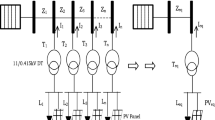Abstract
Based on the analysis of the interaction mechanism between the photovoltaic grid-connected inverter and the background harmonic of the distribution network, an optimal planning strategy for changing the equivalent impedance of the common connection point from the grid side of the inverter to suppress the harmonic amplification of the grid-side harmonic voltage near the resonant frequency point is proposed. The optimization strategy is based on the static distribution network reconfiguration and photovoltaic configuration as the main means to optimize the equivalent impedance of the photovoltaic grid-connected point. At the same time, the active network loss and voltage deviation of the distribution network are optimized, and the mean value of harmonic voltage distortion rate, network loss and voltage deviation of harmonic monitoring points are taken as the objective function. At the same time, the harmonic monitoring points are optimized by the Pearson correlation coefficient, and the harmonic level of the whole distribution system is reflected by the harmonic monitoring points. Taking IEEE-33 and IEEE-69 bus distribution systems as examples for comparative analysis, the NSGAII algorithm is used to solve the problem. The results show that the joint optimization of distribution network reconfiguration and photovoltaic configuration can effectively suppress the interaction between photovoltaic injection harmonics and background harmonics of the distribution network. It effectively reduces the active power loss of the whole distribution network and the voltage deviation of the distribution network bus, and improves the minimum voltage of the distribution network. The effectiveness of the proposed PV optimal configuration strategy is verified by comparing the examples of different distribution systems.












Similar content being viewed by others
References
Liu Q, Li Y, Luo L (2019) Power quality management of PV power plant with transformer integrated filtering method. IEEE Trans Power Deliv 34(3):941–949
Todeschini G, Balasubramaniam S, Igic P (2019) Time-domain modeling of a distribution system to predict harmonic interaction between PV converters. IEEE Trans Sustain Energy 10(3):1450–1458
Song SJ, Wei Z, Lin YZ, Liu B (2020) Impedance modeling and stability analysis of PV grid-connected inverter systems considering frequency coupling. CSEE J Power Energy Syst 6(2):279–290
Padmavathi L, Janakiraman PA (2011) Self-tuned feed-forward compensation for harmonic reduction in single-phase low-voltage inverter. IEEE Trans Ind Electron 58(10):4753–4762
Marko V, Predrag M, Srete N (2018) Distributed generation harmonic interaction in the active distribution network. Tehnički Vjesnik 25(6)
Fei W, Xiayun F, Lijun Z, Yan D (2018) Impedance-based analysis of grid harmonic interactions between aggregated flyback micro-inverter and the grid. IET Power Electron 11(3)
Zhou X, Xu D, Huang Y (2022) Impedance characteristics and harmonic analysis of LCL-type grid-connected converter cluster. Energies 15(10):3708
Wang F, Duarte JL, Hendrix MAM (2011) Modeling and analysis of grid harmonic distortion impact of aggregated DG inverter. IEEE Trans Power Electron 26(3):786–797
Agorreta JL, Borrega M, Lopez J (2011) Modeling and control of N-paralleled grid-connected inverter with LCL filter coupled due to grid impedance in PV plants. IEEE Trans Power Electron 26(3):770–785
Leijiao G, Jiaheng L, Bo W (2021) Improved adaptive gray wolf genetic algorithm for photovoltaic intelligent edge terminal optimal configuration. Comput Electr Eng 95:107394
Abbas AS, El-Sehiemy RA, Abou E-EA (2021) Optimal harmonic mitigation in distribution systems with inverter based distributed generation. Appl Sci 11(2):774
Rodríguez-Pajarón P, Hernández A, Milanović JV (2022) Estimation of harmonics in partly monitored residential distribution networks with unknown parameters and topology. IEEE Trans Smart Grid 13(4):3014–3027
Camilo FM, Almeida ME, Castro R, Fernão Pires V (2022) Multi-conductor Line models for harmonic load-flow calculations in LV networks with high penetration of PV generation. J Mod Power Syst Clean Energy 10(5):1288–1301
Zhou W, Wang Y, Chen Z (2020) Impedance-decoupled modeling method of multiport transmission network in inverter-fed power plant. IEEE Trans Ind Appl 56(1):611–621
Bharath KA, Abhyankar AR (2022) Normal-transformation-based probabilistic load flow with correlated wind and load forecast errors. Renew Energy Focus 43
Xie X, Peng F, Zhang Y (2022) A data-driven probabilistic harmonic power flow approach in power distribution systems with PV generations. Appl Energy 321
Wang H-J, Pan J-S, Nguyen T (2022) The distribution network reconfiguration with distributed generation based on parallel slime mould algorithm. Energy 244(PB)
Yahya N, Seyed HH, Saeid GZ (2018) An overview of power quality enhancement techniques applied to distributed generation in electrical distribution networks. Renew Sustain Energy Rev 93
Jacek C (2019) Certainty equivalent under cumulative prospect theory. Int J Uncertain Fuzziness Knowl-Based Syst 27(3):415–428
Cao R, Xing J, Sui B (2021) An improved integrated cumulant method by probability distribution pre-identification in power system with wind generation. IEEE Access 9:107589–107599
Liu Q, Liu X, Wu J (2019) An improved NSGA-III algorithm using genetic K-means clustering algorithm. IEEE Access 75(01)
Xu X, Jia Y, Lai CS (2020) Bi-level optimal planning of voltage regulator in distribution system considering maximization of incentive-based photovoltaic energy integration. CSEE J Power Energy Syst. https://doi.org/10.17775/CSEEJPES.2020.01230
Kukkonen S, Deb K (2006) Improved pruning of non-dominated solutions based on crowding distance for bi-objective optimization problems. In: IEEE Congress on Evolutionary Computation, Vancouver, IEEE pp 1178–1186
Acknowledgements
This research was funded by the China Southern Power Grid Corporation Science and Technology Project [090000KK52200148/SZKJXM20200492].
Author information
Authors and Affiliations
Corresponding author
Additional information
Publisher's Note
Springer Nature remains neutral with regard to jurisdictional claims in published maps and institutional affiliations.
Rights and permissions
Springer Nature or its licensor (e.g. a society or other partner) holds exclusive rights to this article under a publishing agreement with the author(s) or other rightsholder(s); author self-archiving of the accepted manuscript version of this article is solely governed by the terms of such publishing agreement and applicable law.
About this article
Cite this article
Sheng, H., Zhu, Q., Tao, J. et al. Distribution Network Reconfiguration and Photovoltaic Optimal Allocation Considering Harmonic Interaction Between Photovoltaic and Distribution Network. J. Electr. Eng. Technol. 19, 17–30 (2024). https://doi.org/10.1007/s42835-023-01506-y
Received:
Revised:
Accepted:
Published:
Issue Date:
DOI: https://doi.org/10.1007/s42835-023-01506-y






